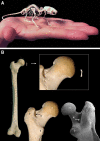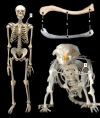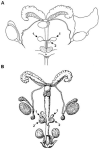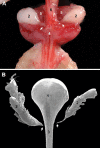Bridging mouse and human anatomies; a knowledge-based approach to comparative anatomy for disease model phenotyping
- PMID: 37421464
- PMCID: PMC10382392
- DOI: 10.1007/s00335-023-10005-4
Bridging mouse and human anatomies; a knowledge-based approach to comparative anatomy for disease model phenotyping
Abstract
The laboratory mouse is the foremost mammalian model used for studying human diseases and is closely anatomically related to humans. Whilst knowledge about human anatomy has been collected throughout the history of mankind, the first comprehensive study of the mouse anatomy was published less than 60 years ago. This has been followed by the more recent publication of several books and resources on mouse anatomy. Nevertheless, to date, our understanding and knowledge of mouse anatomy is far from being at the same level as that of humans. In addition, the alignment between current mouse and human anatomy nomenclatures is far from being as developed as those existing between other species, such as domestic animals and humans. To close this gap, more in depth mouse anatomical research is needed and it will be necessary to extent and refine the current vocabulary of mouse anatomical terms.
© 2023. The Author(s).
Conflict of interest statement
The authors declare no competing interests.
Figures








Similar articles
-
Of mice and men: aligning mouse and human anatomies.AMIA Annu Symp Proc. 2005;2005:61-5. AMIA Annu Symp Proc. 2005. PMID: 16779002 Free PMC article.
-
Developmental anatomy of the heart: a tale of mice and man.Physiol Genomics. 2003 Nov 11;15(3):165-76. doi: 10.1152/physiolgenomics.00033.2003. Physiol Genomics. 2003. PMID: 14612588 Review.
-
[THE ORIGINS OF THE MUSCULI TENSOR AND LEVATOR VELI PALATINI IN DOMESTIC MAMMALS].Verh Anat Ges. 1964;58:313-8. Verh Anat Ges. 1964. PMID: 14176798 German. No abstract available.
-
[Main branches of the internal iliac artery in man and domestic mammals in a comparative anatomical study].Anat Anz. 1971;128(5):439-53. Anat Anz. 1971. PMID: 5111270 German. No abstract available.
-
Reasonable classical concepts in human lower limb anatomy from the viewpoint of the primitive persistent sciatic artery and twisting human lower limb.Okajimas Folia Anat Jpn. 2010 Nov;87(3):141-9. doi: 10.2535/ofaj.87.141. Okajimas Folia Anat Jpn. 2010. PMID: 21174944 Review.
Cited by
-
Modeling reproductive and pregnancy-associated tissues using organ-on-chip platforms: challenges, limitations, and the high throughput data frontier.Front Bioeng Biotechnol. 2025 Apr 1;13:1568389. doi: 10.3389/fbioe.2025.1568389. eCollection 2025. Front Bioeng Biotechnol. 2025. PMID: 40236940 Free PMC article. Review.
-
Nonhuman primate models of pediatric viral diseases.Front Cell Infect Microbiol. 2024 Dec 3;14:1493885. doi: 10.3389/fcimb.2024.1493885. eCollection 2024. Front Cell Infect Microbiol. 2024. PMID: 39691699 Free PMC article. Review.
-
Lack of TRIC-B dysregulates cytoskeleton assembly, trapping β-catenin at osteoblast adhesion sites.FEBS J. 2025 Apr;292(8):1920-1933. doi: 10.1111/febs.17399. Epub 2025 Jan 20. FEBS J. 2025. PMID: 39834042 Free PMC article.
-
Genetic models of fibrillinopathies.Genetics. 2024 Jan 3;226(1):iyad189. doi: 10.1093/genetics/iyad189. Genetics. 2024. PMID: 37972149 Free PMC article. Review.
-
Proteomic reference map for sarcopenia research: mass spectrometric identification of key muscle proteins located in the sarcomere, cytoskeleton and the extracellular matrix.Eur J Transl Myol. 2024 May 24;34(2):12564. doi: 10.4081/ejtm.2024.12564. Eur J Transl Myol. 2024. PMID: 38787300 Free PMC article.
References
-
- Akabori E. Septal apertures in the humerus on Japanese, Ainu and Koreans. Am J Phys Anthropol. 1934;18:395–400.
-
- Bard JBL, Kaufman MH, Dubreuil C, Brune RM, Burger A, Baldock RA, Davidson DR. An internet-accessible database of mouse developmental anatomy based on a systematic nomenclature. Mech Dev. 1998;74:111–120. - PubMed
Publication types
MeSH terms
LinkOut - more resources
Full Text Sources
Medical
Miscellaneous

